Column

Column | Did the Miami Grand Prix live up to the hype?
It’s no secret that F1 has made the United States a key growth market in recent years. With the production and marketing of Drive to Survive and the announcement of the Las Vegas Grand Prix for 2023, it’s clear that the top brass of the sport aim to increase F1’s appeal stateside. F1’s latest venture, the Miami Grand Prix, was met with great success, demonstrating that F1 is ready to thrive in the US.
The Build-Up
Drive to Survive has played an integral role in F1’s rising popularity in foreign markets. While more serious fans may criticize the way D2S misrepresents relationships and rivalries, there is no doubt that the opera-esque nature of the series has hooked in new fans. F1 CEO Stefano Domenicali states, “I’m not going to deny that Netflix was very important in this market for the growth and awareness.”
With the increased use of social media and platforms like YouTube, Liberty Media is attempting to drive engagement particularly with younger fans. Domenicali continues, “The availability of our content has to meet the needs of the customer. The new generation wants to be connected to what they love at the time they want. We need to understand that.”
“We need to create spectacle,” says Domenicali. With attractions and gimmicks like the fake marina, beach club, and eventual podium ceremony, there was an immense spotlight on F1. The event was aggressively branded across all platforms as “F1’s Super Bowl”. The location was a deciding factor — the Hard Rock Stadium is one of the most lavish sports facilities in the country, having hosted the Super Bowl in 2020. Miami itself has a reputation for being upscale and glamorous. Across the board, the top brass have attempted to “americanize” F1.
The hype around the event drew parallels to the Monaco Grand Prix, as some of the most popular celebrities flocked to watch the race. Sporting stars like Michael Jordan and Tom Brady, singers like Pharell and Shawn Mendes, and actors like Dwayne Johnson and Renee Zellweger were in attendance. The glitz certainly attracted many viewers to the race, many of them completely new to the sport.
How many GOATs are in this picture? pic.twitter.com/tBXpMVusPj
— Sports Illustrated (@SInow) May 8, 2022
The Numbers
The popularity and spectacle of the Miami Grand Prix is reflected in the ticket sales. The event sold out the approximately 80,000 tickets on offer, and there were as many as 250,000 ticket requests. Tickets cost an average of $2414 according to SeatGeek, not including accommodations and other bells and whistles. This is substantially higher than the cost to attend most other grand prix. If the event organizers can improve the quality of the accommodations (which were admittedly poor in some areas), it is possible that next year’s event may see similar rates.
F1 has been steadily growing its American TV viewership as well. While the official numbers for the Miami Grand Prix have not been released yet, they are projected to be at a record high. In 2021, ESPN averaged 934,000 viewers per race. This year, that number has jumped to 1.1 million on average per race (with the highest so far being 1.4 million viewers for the Saudi Arabian Grand Prix). Given the more convenient time slot of the race, there is a good probability that the Miami Grand Prix might break ESPN’s viewership record in recent history. If the rumors are to be believed, F1 is pursuing an annual $75 million deal for the broadcasting rights in the US. This only confirms F1’s plans to expand in the US.
Although it will be difficult for F1 to compete with long-established sports like basketball and baseball in this market, the sport has a bright future in the US. Other sports, like golf, have taken inspiration and followed F1’s business model. As Stefano Domenicali concludes, “We believe we can have an incredible and bright future in the US, so we need to make the best decision in terms of Formula One in the US."



















































